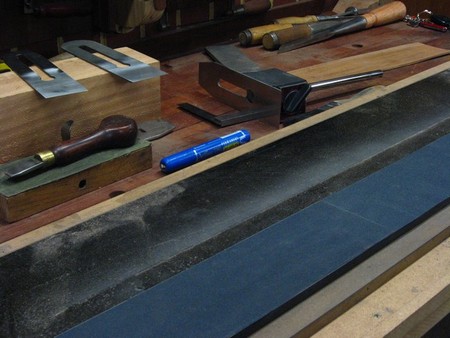In the tutorials from all the Internet wizards they always manage to prep a plane iron in 10 minutes max. And they imply that you are an idiot when it takes you any longer. So either i am an idiot or they are. At least with vintage irons it always takes me ages. I just bought 3 very nice old Stanley planes and yesterday I spend a major chunck of the evening to flatten the back of the #3.
First, it was very convex with severely drooped corners. There is some pitting but really not much. So I first get my floor tile and the 80 grit SiC loose grit. That works very fast to cut through the crap, so onto a 400 bester, a 1000 sigma and my polishing stones. Within half an hour I had a sharp edge. Next job is fitting the capiron, bending and hamering it straight again and then trying to mate it to the back of the iron. No such luck! After several fruitless attempts I checked the back of my iron with a straight edge and found a severely convex back! Somehow my stones have been hollow (despite flattening them).
That brings me to my rant. I have some diamond plates, which have given up the gost in no time. They are really useless for this kind of work. I have oilstones which are too slow. I have waterstones which dish on a wink of the eye.
In the end I want to have a good fit between iron and chipbreaker. Cutting corners just doesn't work to get them to fit nicely.
Ok. I went to bed way too late and am still nowhere near finished. The weekend is coming up luckily and it looks like I will have some black fingernails when I get back to work next week.
Thanks for ranting, feel much better now.





 Reply With Quote
Reply With Quote





 ).
).

